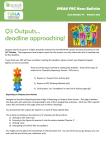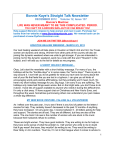Download Changes in Me - Preparing To Teach About Puberty
Transcript
Teacher Guide Preparing To Teach About Puberty Why should I talk to my students about sexuality? When many people hear the word “sexuality”, they often hear only the first syllable. However, sexuality is not the same as sex. Sexuality includes everything that defines us as girls and boys, men and women. Teaching your students about sexuality requires more than simply explaining anatomy and reproduction - it means talking to them about relationships, families, parenthood and good decision-making. Sexuality encompasses our physical development, sexual knowledge, attitudes, values and behaviours - it is shaped not solely by our biology and psychology, but also by our culture, family history, education, and experiences. When you teach your students about sexuality, and not just about ‘sex’, you are giving them the skills they need to develop positive relationships throughout their lives. Children learn about sex and sexuality every day, yet the information they receive from the media and from their peers may be incorrect or ineffective. When children are given honest and accurate information from their teachers and parents, they can learn to make responsible decisions. Talking to your students about sexuality and puberty enables them to grow into sexually healthy adults. But I don’t know much about puberty. What do I need to know? Teachers often feel nervous before they talk with children about puberty and sexuality. One of the best ways to increase your comfort level with the subject matter is to consult a variety of reliable resources. The next two sections are designed to provide you with some background information concerning puberty and sexuality. Additionally, should you wish to conduct further research, you will find a comprehensive list of resources at the end of this document. Changes In Me: A Puberty and Adolescent Development Resource for Educators Junior Grade Level, Second Edition Peel Public Health, Healthy Sexuality Program, 905-799-7700 3 Teacher Guide Preparing To Teach About Puberty What changes will children experience during puberty? Children experience physical, emotional and social changes throughout puberty. Some of the most common physical changes are listed in the chart below. Physical Changes: GIRLS BOYS Increase in the production of the hormone estrogen Increase in the production of the hormone testosterone May develop acne May develop acne Perspiration will increase which may cause Perspiration will increase which may body odour cause body odour Hair will grow on the body Hair will grow on the body Body will grow taller Body will grow taller Hips broaden Shoulders and chest broaden Breasts develop Testes and scrotal sac develop Pubic hair develops Pubic hair develops Voice changes and get deeper (Larynx grows) Voice changes and gets deeper (Larynx grows) Underarm and leg hair grows Underarm, leg hair, chest hair and facial hair grows Menstruation begins Penis grows “Wet dreams” may occur “Wet dreams” may occur Changes In Me: A Puberty and Adolescent Development Resource for Educators Junior Grade Level, Second Edition Peel Public Health, Healthy Sexuality Program, 905-799-7700 4 Teacher Guide Preparing To Teach About Puberty The following is a description of the physical changes girls and boys experience during puberty. The Pituitary Gland and Hormones In both boys and girls, puberty starts with the release of hormones from the pituitary gland – a pea shaped gland located in the brain. Hormones are chemical messengers that allow different parts of the body to communicate with each other. In girls, the pituitary gland sends a chemical hormonal message to the ovaries to start producing and releasing the hormone called estrogen. In boys, the pituitary gland sends a similar chemical hormonal message to the testicles to start producing and releasing the hormone called testosterone. These hormones are responsible for many of the changes associated with puberty. Ovulation and Menstruation In girls, hormones released from the pituitary gland send a message to the ovaries – two grape-sized organs located in the lower pelvic region of the female. The ovaries then begin to release estrogen, which in turn leads to the release of ova or eggs – female reproductive cells. This process is called ovulation – it occurs approximately once per month, usually one egg is released from alterative ovaries, from the onset of puberty until a female reaches menopause. Females are actually born with all the eggs they will ever use over their lifetime. However, it is not until puberty that these eggs become mature and are released from the ovaries. Once ovulation occurs, the released egg is caught by the fallopian tube moves the egg down to the uterus. The uterus or womb is a pear-shaped muscular organ where a fertilized egg can develop into a fetus. A female’s uterus is where a fetus grows. Over the course of approximately one month, the endometrial lining inside the uterus thickens. If an egg cell is fertilized by a male’s sperm cell, the resulting embryo implants itself in this nourishing lining in the uterus. A fertilized egg or embryo takes about 40 weeks to develop into a full term baby. When the egg is not fertilized, the thick lining is not needed, and the lining sloughs off the sides of the uterus and out of the body through the cervix – the mouth of the uterus leading to the vagina - and then through the vagina. This process is called menstruation. Changes In Me: A Puberty and Adolescent Development Resource for Educators Junior Grade Level, Second Edition Peel Public Health, Healthy Sexuality Program, 905-799-7700 5 Teacher Guide Preparing To Teach About Puberty Menstruation can last somewhere between three and seven days. The blood that is lost during menstruation can be absorbed with a tampon or a sanitary napkin. As the facilitator of the class, you may want to share samples of these items with your students. It is also important to explain how these items are used. Some girls and women may experience P.M.S. – pre-menstrual syndrome. Symptoms of P.M.S. may include lower abdominal cramping, backache and bloating. These symptoms can be relieved by limiting salt intake, drinking plenty of water, getting light exercise (stretching or walking), applying heat through a hot water bottle or heating pad, or taking a pain reliever. Remind your students that they should always ask their parents before taking any medication. Ejaculation In boys, the pituitary gland sends a message to the testicles to start releasing more testosterone. In turn, the testicles begin to produce sperm – the male reproductive cells. This process, in which males produce functional sperm, is called spermatogenesis. The testicles - two walnut-sized glands - are protected by a sac called the scrotum. The scrotum helps to regulate the temperature of the testicles. Testicles need to be kept slightly cooler than the rest of the body. Sperm from the testicles move to the epididymis where they mature. During ejaculation, sperm from the epididymis move through the vas deferens – a slim duct of the testicle - to collect semen. Semen - a whitish-yellow fluid that nourishes the sperm - is a combination of fluid produced from three glands: the prostate, the seminal vesicles, and the Cowper’s glands. Sperm make up about 1% of the ejaculatory fluid; the rest of the fluid is semen. In each ejaculation, there are about two hundred and fifty million sperm. For ejaculation to occur, the penis must be erect. A penis can become erect in reaction to cold, the urge to urinate, during sleep cycles, or from sexually arousing thoughts or touch. During puberty, erections can occur for no particular reason and without warning. Three large vesicles inside the penis engorge with blood during sexual excitement. The penis becomes hard or erect because of the rush of blood that fills the penis. The semen is ejaculated through the urethra – the same tube that allows for urination. A male cannot ejaculate and urinate at the same time. A special valve called the urethral sphincter shuts off the possibility of urination during ejaculation. During puberty, it is not unusual for a boy to experience wet dreams – an involuntary release of semen that occurs while a boy is sleeping. Changes In Me: A Puberty and Adolescent Development Resource for Educators Junior Grade Level, Second Edition Peel Public Health, Healthy Sexuality Program, 905-799-7700 6 Teacher Guide Preparing To Teach About Puberty Fertilization Fertilization results when the sperm meets the egg. Usually, this occurs during sexual intercourse - when the male’s penis is inserted inside the female’s vagina and ejaculation occurs. Sperm swim through the vagina into the uterus to locate an egg in the fallopian tube. Sperm can live about three to five days inside a female’s reproductive system. If the egg is not present at the moment of ejaculation, the sperm may still be able to fertilize an egg released in the days following sexual intercourse. An egg is fertilized in the fallopian tube. Within a few days the fertilized egg, also known as a zygote/embryo travels through the fallopian tube and it attaches itself to the thickened lining of the uterus. It takes about 40 weeks for the implanted embryo or fetus to become a fully developed baby. Fertilization can also occur through intrauterine insemination (IUI). In IUI, prepared sperm is introduced into the woman's uterus at around the time of ovulation, with the aim of getting the sperm nearer to the egg for fertilization. Another option is in vitro fertilization (IVF). In IVF, eggs are gathered from the woman's ovaries and mixed with the man's sperm in a dish in the laboratory. The egg may become fertilized, which results in an embryo. A female can become pregnant when the embryo is inserted into the vagina or at the base of the uterus. Circumcision Circumcision is the term for the surgical procedure that removes the loose skin, called the foreskin, which covers the tip of the penis. Circumcision is usually performed as an expression of cultural norms or religious beliefs. Males with uncircumcised penises should be taught to clean the tip of their penis by pulling back the foreskin and washing underneath. This can easily be done while taking a shower or a bath. Wet Dreams While it is common knowledge that males experience wet dreams during puberty, it is a lesser known fact that females may also experience wet dreams during puberty. Since females produce vaginal lubrication inside their bodies, girls may find vaginal secretions in their underwear or experience a wet feeling between their legs when they wake up, but they will not normally need to change and wash their bed sheets after experiencing a wet dream. Parents may never be aware of their daughter’s wet dreams. In contrast, when boys experience wet dreams, they ejaculate outside their bodies and the semen Changes In Me: A Puberty and Adolescent Development Resource for Educators Junior Grade Level, Second Edition Peel Public Health, Healthy Sexuality Program, 905-799-7700 7 Teacher Guide Preparing To Teach About Puberty frequently wets their bedding. Boys can be encouraged to change and wash their own sheets, should they wish. Both boys and girls need to be informed that wet dreams are very common and a natural part of puberty as young people develop sexual thoughts and feelings, even during sleep. Emotional Changes: The hormones that trigger physical changes during puberty also affect children and teens’ feelings. Some children experience swift changes in their moods, and may become increasingly nervous or withdrawn, while others may be confident and positive about the changes in themselves. Many young people become increasingly interested in their appearance and in their bodies. Preteens may develop romantic feelings towards their peers. While every child is different, it is common for all young people to experience some basic changes. Intense emotions, including happiness, love, anger, frustration, sadness and sexual feelings often accompany puberty. It is important to affirm your students by letting them know that what they are feeling is a natural part of the maturing process. Social Changes: During puberty and into adolescence, most young people desire increased independence. There is a period of gradual maturation and separation from their families. During this time, friends, peers and teachers play an increasingly important role in the lives of teens. It is crucial that lines of communication remain open between parents/caregivers and their children at this time. This way, teens can remain emotionally and socially connected to their families while also exploring their individual identities, friendships and relationships. It is also important to be aware of the relationship between physical development and sexual development. At each stage of physical development, children may explore their sexuality. The following chart outlines the sexual changes that children experience as they mature. Changes In Me: A Puberty and Adolescent Development Resource for Educators Junior Grade Level, Second Edition Peel Public Health, Healthy Sexuality Program, 905-799-7700 8 Teacher Guide Preparing To Teach About Puberty What To Expect From Birth To Age 2: Learn about love and trust through loving relationships with parents and their caregivers Explore their bodies including their genitals Experience genital pleasure – through their own touch May have erections or lubricate vaginally Begin to notice differences between the bodies of boys and girls, children and adults What To Expect From Age 3 To Age 5: Become very curious about bodies, and the differences between boys and girls May play “house”, “doctor”, forms of body exploration or "sex play" with friends Learn they are either male or female Learn about female/male roles by observing others Enjoy learning about, and talking about, body parts and functions Find adult bathroom activities interesting Ask questions about birth or pregnancy such as, “Where do babies come from?” May learn words related to sex and try using them May mimic adult sexual behaviour May begin to masturbate Changes In Me: A Puberty and Adolescent Development Resource for Educators Junior Grade Level, Second Edition Peel Public Health, Healthy Sexuality Program, 905-799-7700 9 Teacher Guide Preparing To Teach About Puberty What To Expect From Age 6 To Age 8: Begin to have strong friendships with children of the same sex Be affected by stories they hear in the media regarding sexual issues, such as abuse Have definite ideas about male and female roles Have a basic sexual orientation and identity Want to be like their peers; for example, boys may feel pressured to choose the type of toys and activities that other boys choose May engage in name-calling and teasing May continue with sex play May begin or continue to masturbate What To Expect From Age 9 To Age 12: May begin the changes of puberty Become more modest and want privacy Continue to value same-sex friendships May experience increased sexual feelings and fantasies Develop crushes on friends, older teens, teachers and celebrities among others Romantic feelings may be directed towards people of the opposite sex Romantic feelings may be directed towards people of the same sex May take part in sexual exploration with peers May masturbate to orgasm May encounter decisions about participating in sexual activities and/or using drugs What To Expect From Age 13 To Age 18: Complete the changes of puberty Place great value on independence Experience increased sexual feelings May desire physical closeness with a partner May face peer pressure to be sexually active whether or not s/he feels ready May change close friendships in favour of romantic relationships May make choices which lead to pregnancy or sexually transmitted infections May encounter violence in relationships (sexual harassment, date rape) Changes In Me: A Puberty and Adolescent Development Resource for Educators Junior Grade Level, Second Edition Peel Public Health, Healthy Sexuality Program, 905-799-7700 10 Teacher Guide Preparing To Teach About Puberty Now that I know more, how do I prepare to teach my students? Teachers are often apprehensive when they are asked to teach students about puberty. In an effort to help educators increase their comfort level, we have included this guide outlining the ways one might prepare to teach about puberty. This involves a number of important tips for educators. ● Consider your own feelings ● Familiarise yourself with the topic ● Be prepared for common questions ● Practice answering questions Preparing For Teaching About Puberty Most effective sexuality education programs include an on-going segment that allows students to ask questions anonymously. This simple strategy enables youth to participate in defining the content of the curriculum. The goal of the “question box” exercise in lesson one is to identify preteens' genuine concerns about puberty and sexuality, and to offer them responses to their inquiries. The responses should be factually correct, guide decision-making, encourage openness, and promote sexually healthy attitudes and behaviours. It can be challenging to answer questions in an age-appropriate manner while also conveying positive sexual health attitudes. The use of the “question box” allows the teacher time to research possible answers and practice delivery of those answers. In sexual education classes, teachers may be asked to answer some challenging questions. Changes In Me: A Puberty and Adolescent Development Resource for Educators Junior Grade Level, Second Edition Peel Public Health, Healthy Sexuality Program, 905-799-7700 11 Teacher Guide Preparing To Teach About Puberty Getting Prepared For Students’ Questions The first step in preparing to answer questions from students in grades four, five and six, is to understand their stage of growth and development. Preteens are intensely curious – they may tease each other, and they are interested in everything including their own bodies. They notice the obvious differences in development (physical, emotional and social) within their peer groups and worry about changes happening too quickly or too slowly. At the beginning of this stage, children are often open and direct in their conversations about sexuality. Children may ask what they want to know outright. How many minutes do you have to stay in sexual intercourse? Why can’t a man have a baby? What causes Siamese twins? Since young people are exposed to so much sexual information in the media, they occasionally ask questions that may seem surprisingly sophisticated. They may ask, for example, about oral sex, intercourse with multiple partners, or homosexuality. The wonderful characteristic about children at this age is that they are still anxious to receive information from adults. They generally enjoy these open exchanges and may barrage you with questions. For this reason, teaching this age group can be particularly fun and rewarding for educators but also a bit daunting! The following guidelines may help you as you prepare your thoughtful answers to your students’ questions: ● When answering questions form the anonymous “question box,” read each question just as it appears on the card. Should a slang term appear, restate the question using the correct terminology. For example, suppose a student in the fifth grade asks, “How big will a boy's dick get to be when he grows up?" You might respond by saying, “‘Dick’ is a slang term for penis,” and restate the question, “How big will a boy’s penis grow when he grows up?”. Then, provide an answer. Reading the question as it is written validates the question and gives you an opportunity to model appropriate language. ● Be honest. If you do not know the answer to a question, say so. Then, research the answer and report back to your students with the correct answer while facilitating this unit. Likewise, if a question is embarrassing, do not try to pretend it's not. Acknowledge that this is a difficult question for you to answer and do your best to answer accurately. Changes In Me: A Puberty and Adolescent Development Resource for Educators Junior Grade Level, Second Edition Peel Public Health, Healthy Sexuality Program, 905-799-7700 12 Teacher Guide Preparing To Teach About Puberty ● Give simple, concrete answers that avoid technical jargon. Choose language that you know preadolescents are able to understand. If you are introducing a new or unfamiliar term, make sure you clearly define it by offering illustrations from their current base of experience. For example, if you are trying to explain how the vagina can expand to allow a baby to be delivered, you might compare it to a balloon that can expand when filled with air but returns to its original size when the air is released. ● Redirect questions about “feelings” back to the students. Questions such as, “Is kissing the first time fun or scary?” can lead to an interesting dialogue if it is managed tactfully. Read the question and then ask the group what they think. Once the students voice their perspectives, you might offer your point of view, if it is appropriate, or summarize the variety of opinions. ● Handle value questions very carefully. Try not to impose your personal values but rather, support universal values such as “it is always wrong to exploit or take advantage of another person”. When value issues arise, as they inevitably will, it is helpful to discuss a range of values. You might say, “Some people believe that … while others think that ...” This approach illustrates to children that people feel differently about value-laden issues – especially relating to sex and sexuality. When a student presents a narrow view or opinion, introduce other points of view. Always encourage students to talk with an adult they trust about value issues related to sexuality, such as a parent, another adult with whom they feel comfortable (aunt/uncle), faith leader, etc… ● Answer explicit questions honestly, but avoid giving explanations of sexual technique. If your students know enough to ask a question, they deserve an age-appropriate answer. Suppose the question is, “What is a blow job?”, you might answer, “A blow job is a slang term for oral sex performed on a males penis. This is also called fellatio. It usually means using the mouth on the penis to give sexual pleasure.” Notice the choice of the words - “using the mouth on the penis” - instead of “licking” or “sucking” the penis. You have avoided using terms that tend to evoke visual images, and used words that are less evocative, but that remain honest and accurate. ● Avoid using sexist language. Do not use stereotypes of women and men in your examples. Be sure to correct students should they present information that is sexist and/or demeaning. The most basic way to use inclusive language is to say, “she or he” when sharing gender-neutral information. It is also very important not to speak as if all youth are heterosexual. Approximately ten percent of the students in your classes are not heterosexual. When talking about relationships, use words like “partner” rather than “boyfriend” or “girlfriend”. Gay, lesbian, bisexual, trans-gendered and trans-sexual students, among others, need to ‘see themselves’ in the curriculum. All students deserve a safe environment in which to learn about puberty and sexuality. Often, after you model appropriate language, your students will begin using the same terms. Changes In Me: A Puberty and Adolescent Development Resource for Educators Junior Grade Level, Second Edition Peel Public Health, Healthy Sexuality Program, 905-799-7700 13 Teacher Guide Preparing To Teach About Puberty Try to empower your students by providing them with concrete solutions to some of the “problems” associated with puberty. When children learn about puberty, they often feel helpless – as if there is little they can do to control the changes they will or already are experiencing. There are many strategies young people can employ to manage the changes that occur during puberty. The following chart outlines suggestion tactics. Remind your students that they can often successfully manage the changes of puberty. How Students Can Deal With The Changes That Occur During Puberty Change What You Can Do Acne Eat a well-balanced diet. Exercise every day (60 minutes is recomended). Drink plenty of water. (Six to eight glasses a day!) Ask a parent or doctor to help you choose an over-the-counter acne soap or medication. See your doctor for advice if the acne worsens. Underarm Odour Bathe regularly. Change your clothes regularly. Ask your doctor or parent to help you choose an antiperspirant deodorant. Growing Pains in the Breasts Some girls find it more comfortable to wear a bra as their breasts get bigger. Ask a parent or trusted adult (e.g., aunt) to help you choose a bra that is right for you. Period/Menstruation Be prepared with a pad or tampon wherever you think you will need one. Keep one in your backpack or purse if you think you may get your period while at school or staying at a friend’s house. Changes In Me: A Puberty and Adolescent Development Resource for Educators Junior Grade Level, Second Edition Peel Public Health, Healthy Sexuality Program, 905-799-7700 14 Teacher Guide Preparing To Teach About Puberty Pre-Menstrual Syndrome (PMS) Erections Do some gentle exercise like walking or stretching which helps to relieve muscle cramps. Drink plenty of water. (Six to eight glasses a day!) Avoid salty foods (e.g., potato chips) and foods with caffeine (e.g., coffee or chocolate) before you get your period. Use a hot water bottle, heating pad or hot bath to help relieve muscle aches or cramps. Ask your parent for advice on taking a pain-reliever. Ask your doctor for advice if menstrual pain is not tolerable. Sometimes erections occur without warning during puberty. Erections may or may not be connected to sexual thoughts. Remember, your body is getting used to all the new hormones. This is normal. You may think everyone can notice, but it’s more likely that they cannot. Erections can go away pretty quickly on their own. Most of your male peers are experiencing the same thing. Talking about your feelings to a friend, older sibling or parent may help if you have concerns. Changes In Me: A Puberty and Adolescent Development Resource for Educators Junior Grade Level, Second Edition Peel Public Health, Healthy Sexuality Program, 905-799-7700 15 Teacher Guide Preparing To Teach About Puberty Wet Dreams Increased Attention to Physical Appearance Romantic Interest Wet dreams are normal during puberty and even during adulthood. You can tell your parents that you prefer to change and wash your own bed sheets. Most of your peers are also experiencing wet dreams. Talking about your feelings to a friend, older sibling, or parent may help you to feel less concerned. Part of looking good is being healthy, clean and feeling strong. Eat a balanced diet, exercise daily, bathe, wash your hair and brush your teeth regularly. Ask your parents to help you buy clothing that you will feel comfortable wearing. Romantic interest in the opposite or same sex is normal. These feelings are new for young adults going through puberty and can sometimes feel exciting, but also confusing. These feelings are normal. Most of your peers are experiencing the same thing. Talking about your feelings to a friend, older sibling, or parent may help if you are feeling confused about your feelings. Changes In Me: A Puberty and Adolescent Development Resource for Educators Junior Grade Level, Second Edition Peel Public Health, Healthy Sexuality Program, 905-799-7700 16 Teacher Guide Preparing To Teach About Puberty Increased Need for Independence Masturbation Unpredictable Changes in Mood Parents or teachers may be nervous about your new independent role because they care about you and want to protect you. You can gain their trust by taking small steps towards independence. Demonstrating responsibility and honesty will help to establish trust, and your parents will be more likely to let you have more independence. Having sex, using drugs, drinking alcohol and/or smoking DO NOT mean you are independent or make you an adult. It is normal to masturbate; it’s also normal not to masturbate. Masturbation should be done in a private place. Unpredictable changes in moods are common during puberty. Talking about your feelings to a friend, older sibling, or parent may help you to better manage your mood changes. Find some ways that help you relax such as listening to music, spending some time alone, exercising, drawing, etc. Changes In Me: A Puberty and Adolescent Development Resource for Educators Junior Grade Level, Second Edition Peel Public Health, Healthy Sexuality Program, 905-799-7700 17 Teacher Guide Preparing To Teach About Puberty Desire to be Accepted and Liked by Your Peer Group Self-respect and self-esteem come from being true to your values and beliefs. Be clear about what values are important to you. Use assertive communication to tell your peers what you are willing and not willing to do. Ask your parents and teachers for support. Inspired by the work of: ReCAPP - ETR Associates’ Resource Center. (2002). Background Information For The Facilitator. www.etr.org. Another important way you can prepare for students’ questions is to practice delivering the answers. Since you will be collecting questions at the end of each class, you have time to review the questions and develop rehearsed answers for delivery during the course of the unit. Take advantage of this situation. Here are a few sample questions and answers. In Lesson One, you will find a more comprehensive list of common student questions, accompanied by helpful sample answers. This information should help prepare you for the common types of questions students may pose. Sample Questions & Answers Why is one breast bigger than the other? The human body consists of many interesting variations and imperfections. Most of us have small differences between the right and left sides of our bodies. For instance, one of our feet is normally slightly bigger than the other. The same is true for organs and body parts such as breasts and testicles. One breast might be a little larger than the other, one testicle may be smaller than the other. These slight variations are not harmful and do not limit or change functional ability (e.g., ability to breastfeed a baby, ability to produce sperm). Changes In Me: A Puberty and Adolescent Development Resource for Educators Junior Grade Level, Second Edition Peel Public Health, Healthy Sexuality Program, 905-799-7700 18 Teacher Guide Preparing To Teach About Puberty Can young people have sex? The answer to this question really depends on what you mean by ‘have sex’. Having sex is much more than just having sexual intercourse such as having a penis in a vagina. For example, someone might touch his penis or touch her clitoris because it feels good. That is a form of sex that is a normal part of childhood for most human beings. Someone who is ready for sex needs to be able to deal with the decisions and consequences related to sexual intercourse. Sexual intercourse is a serious action that can be a way of showing affection or love in a relationship, but it can also lead to grownup consequences like becoming pregnant or contracting certain diseases. Nurses who worked in classrooms with students in grades four, five and six collected the following questions. As you will see, questions on this list may be challenging to answer. Taking the time to consider how you would answer some of these questions might be advantageous. Other Questions To Expect: What is the protection for a boy not to get a girl pregnant? Why is it difficult to talk with my mom/dad/caregiver about sex? What does sex feel like? Do you think sex is bad or good? Can a woman get pregnant from swallowing sperm? How old were you when you had sex the first time? I'm worried. Some wet stuff comes out of my vagina sometimes. Do I have a disease? Do animals and humans have sex the same way? What is masturbation? Is it okay? Does your period come on without warning? What happens when a man has a sex-change operation? Is sex better with a big penis? How do two women have sex together? How do two men have sex? Why do boys like to touch girls on the butt? What is a good age to start dating? Changes In Me: A Puberty and Adolescent Development Resource for Educators Junior Grade Level, Second Edition Peel Public Health, Healthy Sexuality Program, 905-799-7700 19 Teacher Guide Preparing To Teach About Puberty Sexual Orientation During childhood, it is quite common for children to have many different kinds of sexual feelings and experiences. During adolescence and into adulthood, people are compelled to define themselves through their sexuality. Though academics generally agree that sexuality includes a spectrum of feelings and actions, teens report enormous pressure to characterize themselves as “straight”. No one is sure what percentage of the population is gay or lesbian but some studies suggest approximately ten percent of people are not heterosexual. This means that approximately ten percent or more of the students in your classes will define themselves, either now or at sometime in their life, as gay, lesbian, bisexual, trans-gendered, trans-sexual, queer, questioning, two-spirited or another sexual orientation other than heterosexual. These students deserve a safe and inclusive environment in which to learn about sexuality. Why is it important to include anti-homophobia work in elementary schools? Sex-role standards and the pressure to adopt sex-typed patterns of behaviour converge on children from a range of sources: including family, peers, authority figures and the media. Children who do not adopt sex-role-stereotyped patterns of behaviour are often the targets of homophobic harassment. Challenging homophobia needs to be initiated with young children in a direct and age-appropriate manner that helps them to develop the skills necessary to resist and decode biased messages. Ethical pedagogy should include anti-homophobia work in the elementary school system. Much research in the field of education has suggested that children learn more effectively when they see themselves reflected in the curriculum. Because parents and youth from the lesbian, gay, bisexual, and transgendered (LGBT) community may not be readily visible in the education system, it is important to bring positive messages about the LGBT community and strategies for challenging homophobia into the classroom. Inclusive curriculum is a powerful tool for positive social change. Curriculum that supports critical thinking empowers students to build a more just society. Schools and educators have a responsibility. The Ontario Human Rights Code provides a specific context for addressing issues of homophobia and heterosexism within the education system. Creating safe environments for students and staff in which they can learn and work free from homophobia is sound pedagogical practice which is mandated through Ontario legislation. __________________________________________________________________ Changes In Me: A Puberty and Adolescent Development Resource for Educators Junior Grade Level, Second Edition Peel Public Health, Healthy Sexuality Program, 905-799-7700 20 Teacher Guide Preparing To Teach About Puberty Definitions of Terms Related to Sexual Orientation* Developing a shared language when working with students about issues of homophobia is important. At the same time, it is also important not to overwhelm primary and junior level students with too many high level definitions. Wherever possible teachers should provide definitions of words as they appear during a lesson. Here is a short list of accessible definitions for elementary school students. Lesbian: A female who is attracted to or is sexually interested in other females. Gay: A male who is attracted to or is sexually interested in other males. Bisexual: A person who is attracted to or is sexually interested in either males or females. Homosexual: Another word for gay or lesbian. Transgendered: A person is transgendered when he or she has the body parts of one sex but feels more like the other sex. For example, when a boy or man really feels like he is a girl or woman. LGBT Community: A short and inclusive way to refer to lesbians, gays, bisexuals, and transgendered people. Heterosexual (Straight): Someone who is attracted to or is sexually interested in the opposite sex, for example, when a female falls in love with a male. Sexual Orientation: This term refers to whether we are attracted to or are sexually interested in males, females or both. Everyone has a sexual orientation, which may change over time or be static. A person’s sexual orientation may be homosexual, bisexual, or heterosexual. Homophobia: Irrational fear, hatred, and discrimination against the LGBT community or people who are believed to be LGBT. Homophobia also includes stereotypes and prejudice. Stereotype: An idea or generalization about a group of people based on some characteristic. (Note: Teachers should give an example to the students and ask them to generate their own examples. Teachers need to talk through these stereotypes with the students so that they don’t reinforce negative ideas about the LGBT communities e.g., All gay men act like women). Changes In Me: A Puberty and Adolescent Development Resource for Educators Junior Grade Level, Second Edition Peel Public Health, Healthy Sexuality Program, 905-799-7700 21 Teacher Guide Preparing To Teach About Puberty Prejudices: A feeling or attitude about all, or nearly all people within a given group (e.g., I don’t like gays). Discrimination: An action that treats people unfairly (e.g., I won’t hire any lesbians in my business). Coming Out: When a gay male, lesbian, or bisexual person shares or talks about his/her sexual orientation with others. *Reproduced with permission from Rainbows and Triangles: A Curriculum Document for Challenging Homophobia and Heterosexism in the K-6 Classroom; Toronto District School Board & Elementary Teachers of Toronto, 2002. Changes In Me: A Puberty and Adolescent Development Resource for Educators Junior Grade Level, Second Edition Peel Public Health, Healthy Sexuality Program, 905-799-7700 22 Teacher Guide Preparing To Teach About Puberty Frequently Asked Questions (FAQs)* The questions in this section are often asked by elementary school students learning about LGBT issues (*source of questions: ten years of work by Toronto District School Board staff in the Human Sexuality Program; the Equity Department; Community group facilitators; 2002). Each question is written as a student may ask it, followed by a suggested teacher response. Teachers need to adapt their responses to ensure that they are age-appropriate for the group of students with whom they are working. 1. Do gay men/lesbians behave in feminine/masculine ways? Students may ask: Do gays act like girls? Do lesbians act like boys? If girls play sports/If boys play with dolls, does that mean they are gay? In a couple, is one like that man and one like the woman? Suggested teacher response: Some gay men may appear feminine and some lesbians may appear masculine. This is how gay men and lesbians are often seen on TV or the movies. Some gays and lesbians may choose to behave and look more like the “opposite sex”. Gay men who are masculine and lesbians who are feminine are usually assumed to be heterosexual. (Note: Teachers may want to help their students to think about mainstream media images of masculinity and femininity, as well as of gays and lesbians.) 2. Why are people gay or lesbian? Student may ask: If a girl plays with girls all the time or boy plays with boys, does that make them gay? How do you know if you are gay? At what age do you become gay? Suggested teacher response: Scientists and researchers have not been able to agree about why people are gay, lesbian, bisexual, or straight. Being gay has to do with a feeling deep inside. Some people know they’re gay from a very early age, while others make that determination when they are grown up. Changes In Me: A Puberty and Adolescent Development Resource for Educators Junior Grade Level, Second Edition Peel Public Health, Healthy Sexuality Program, 905-799-7700 23 Teacher Guide Preparing To Teach About Puberty 3. Is homosexuality against religion? Students may ask: What if you find out you’re gay and your religion thinks it’s wrong? Doesn’t God punish gays? Isn’t it a sin? Suggested teacher response: Sometimes even within the same religion people disagree. Some religions consider homosexuality a sin; others consider it is a personal choice, while others consider it a gift from God. There are individuals of all sexual orientations in every religious and cultural group around the world. 4. Why does homophobia exist? Students may ask: If being lesbian and gay isn’t bad, why does everyone use those words to mean something bad? Why does everyone hate gays and lesbians? Suggested teacher response: Some people put down gays and lesbians because they are prejudiced. This is known as homophobia. Sometimes people are afraid of what they don’t understand or they may want to feel better about themselves so they put down someone else. There are lots of people and groups that get put down for many reasons but this does not mean that there is something wrong with them. Each one of us should treat all people fairly and in the same way that we want to be treated. This is what respect means. (Note: Teachers may want to have students make a list of the reasons people get put down in order to explore discrimination and make a link between homophobia, racism, sexism, classism, discrimination against people with disabilities, and discrimination based on physical appearance.) 5. Do children need a mother and father? Students may ask: If kids have two dads, but no mom, do they miss having a mom? Can you be normal without a mom and a dad? Suggested teacher response: Good parenting does not depend on sexual orientation; rather, it depends on a parent's ability to create a loving and nurturing home, something both gay and straight parents can do. Home environments with gay parents can be as effective in fostering a child's development as those with heterosexual parents; the children of gay parents are able to grow up as happy, healthy and well-adjusted as the children of straight parents. Changes In Me: A Puberty and Adolescent Development Resource for Educators Junior Grade Level, Second Edition Peel Public Health, Healthy Sexuality Program, 905-799-7700 24 Teacher Guide Preparing To Teach About Puberty 6. Do gays and lesbians have “normal” relationships? Students may ask: Can they get married? Can they have babies? Don’t they want to get married and have babies? Suggested teacher response: In some countries, gays and lesbians can get legally married. Many same-sex couples are having their relationships recognized and celebrated in their churches, synagogues, or other places of worship. Many gays and lesbians have children either through relationships they had with the “opposite sex” before they came out or within their same-sex relationships. Sometimes, they may need help from a doctor to become pregnant or they may adopt a baby. Also, like heterosexual individuals, not all people who identify as LGBT want to get married or have children. 7. Are homosexuals more promiscuous than heterosexuals? Students may ask: Do gays have sex 24-7? Are gays perverts? Do they have lots of girl/boyfriends at the same time? Suggested teacher response: Just like heterosexuals, not all gays or lesbians are promiscuous. Although being gay, lesbian, bisexual and straight is about sexuality in terms of to whom one is sexually attracted, orientation encompasses more than just sex. Sexual orientation is about the richness and fullness of people’s lives, which includes things like love, community and culture, language, and family. 8. Is sexual orientation a choice? Students may ask: How come people are gay or lesbian? Why would anyone want to be gay or lesbian? Are people born with it? Suggested teacher response: The answer to this question differs from person to person. Some people say that they made a conscious choice, while others feel that they were born lesbian, gay, bisexual, or straight. A person’s right to choose should be respected, and regardless of whether a person has chosen their sexual orientation or not, it’s not okay to discriminate. (Note: You may want to give different examples of human rights protections where some are chosen, for example, the right not to be discriminated against based on marital status, and where some are mostly biological, such as the right not to be discriminated against based on skin colour or sex.) Changes In Me: A Puberty and Adolescent Development Resource for Educators Junior Grade Level, Second Edition Peel Public Health, Healthy Sexuality Program, 905-799-7700 25 Teacher Guide Preparing To Teach About Puberty 9. Can sexual orientation be changed? Students may ask: Are there doctors who can help change gays and lesbians? Don’t people want to change? Can’t they be made to change? Suggested teacher response: A small percentage of gays and lesbians have tried to change their sexual orientation because of the homophobia and discrimination they have experienced. Most psychiatrists offering treatment have high failure rates because it’s impossible to change the unknown situations that produce homosexuality or heterosexuality. It is the opinion of many in the mental health profession that attempts to change one’s sexual orientation can do more harm than good, as it only deepens the wounds of internalized homophobia. 10. Why do gays and lesbians have to come out? Students may ask: Why do they have to talk about it all the time? Suggested teacher response: LGBT people are an “invisible minority” and are often mistaken for, or assumed to be, heterosexual. Coming out allows people to acknowledge the diversity that exists within the LGBT communities. It’s important to note that coming out isn’t restricted to gays and lesbians. It happens all the time within the heterosexual communities. Coming out is more than just telling someone what your sexual orientation may be. Heterosexuals come out by wearing wedding rings, using titles like Miss or Mrs., talking about their partners, sharing pictures of their spouses, and so on. Coming out is an ongoing process that is different for everybody. Some people are only comfortable coming out to their close friends, while others aren’t comfortable coming out at all because it may not be safe enough for them to do so. 11. Is homosexuality the main cause of AIDS? Students may ask: Don’t gays cause AIDS? Isn’t AIDS a curse from God? Suggested teacher response: While the gay community in North America has suffered the negative affects of HIV/AIDS, the vast majority of gay men are HIV negative. Looking at global trends, most people with HIV/AIDS are heterosexual. The HIV virus does not discriminate between gay and straight individuals. Changes In Me: A Puberty and Adolescent Development Resource for Educators Junior Grade Level, Second Edition Peel Public Health, Healthy Sexuality Program, 905-799-7700 26 Teacher Guide Preparing To Teach About Puberty 12. Why is there a Gay Pride Day? There’s no “Straight Pride Day.” Students may ask: What is Gay Pride Day? You don’t see straight people having a parade. Suggested teacher response: While there is no specific day for straight people to be proud of their sexual orientation, there isn’t any day during the year when they can’t be open about their orientation. Heterosexual engagement parties, weddings, and engage in affectionate behaviour with an opposite-sex partner publicly, are all acceptable ways that heterosexuals show their “straight pride.” LGBT people often have to live every day in a world that hasn’t yet come to accept that they deserve the same rights and freedoms afforded to heterosexuals. Lesbian and Gay Pride Day is a day for the LGBT community and its supporters to come together to feel strong and proud, celebrate accomplishments, mourn losses and protest oppression. 13. Are all gays and lesbians white, Anglo, and from North America? Students may say: There are no gays in my culture/country/religion. Until we came to North America/Canada, this was not a problem in my culture. Suggested teacher response: It’s easy to understand why some people would conclude that all gays and lesbians are white or from North America. When gay people are represented in the media, like many media images, they are most often white. What becomes difficult is explaining why this seems to occur in real life. In order to understand why it appears this way, we need to understand different forms of oppression. For LGBT people who experience rejection within their own cultural, ethnic, or religious groups, it can be difficult to come out when they do come out, they often feel they have no place to turn and believe that their community rejects them because of their race, religion, etc… as well as their sexual orientation. Unfortunately, racism, sexism and discrimination against people with disabilities, classism, ageism and even homophobia are as alive and well in the gay community as they are in the rest of society. Changes In Me: A Puberty and Adolescent Development Resource for Educators Junior Grade Level, Second Edition Peel Public Health, Healthy Sexuality Program, 905-799-7700 27 Teacher Guide Preparing To Teach About Puberty 14. Do the chances of homosexuality increase if the person’s parents are gay or lesbian? Students may say: I don’t think gays should have children because they may become gay. Gays have a bad influence on kids because they recruit. Suggested teacher response: Gay, lesbian, bisexual and straight parents cannot necessarily affect the outcome of their child’s sexual orientation. Remember that most gays and lesbians were raised by parent(s) and in a culture where messages with regard to sexual “norms” are almost exclusively heterosexual. If a child grows up in a home with lesbian moms or gay dads, the child may have an easier time accepting their own sexual orientation if they do, in fact, determine that they are gay or lesbian themselves. 15. Are bisexuals more accepted than gays and lesbians? Students may ask: Isn’t it “in” to be bi now? Bisexual girls are always sexy in the movies. Suggested teacher response: The current perception is that society is more accepting of bisexuality. However, this is not always the case. Bisexuals are subject to homophobia and biphobia from both the straight and gay communities, respectively. Some common stereotypes are: that their sexual identity is always changing between straight and gay; that they are promiscuous; that they are confused; and think they are trying to keep “one foot in the closet” by not just admitting that they are gay or lesbian. 16. Is homosexuality a mental illness? Students may ask: Is being gay an illness. Can’t they go to a doctor or something? Are gays crazy?. Suggested teacher response: No, homosexuality is not a mental illness. At one time, being gay, lesbian or bisexual was considered to be a mental illness, but it was removed form the Diagnostic and Statistical Manual (DSM) of mental disorders in 1973 after research showed that gay people are no more likely to suffer mental illness than straight people. Changes In Me: A Puberty and Adolescent Development Resource for Educators Junior Grade Level, Second Edition Peel Public Health, Healthy Sexuality Program, 905-799-7700 28 Teacher Guide Preparing To Teach About Puberty 17. Do gay men molest children? Students may ask: Do they hurt kids? Do you think they should work with kids? Should gay men be allowed to be teachers? Suggested teacher response: Statistics show that the majority of child molesters are heterosexual men who abuse children within the context of the nuclear family. Most male abusers are related to the children they abuse. An adult man who is only sexually attracted to young boys is not gay, but is instead defined as a pedophile. Pedophilia has little to do with the gender of the young person or the adult and more to do with the power the adult has over that child. 18. Do lesbians hate men? Students may ask: Have their dads abused them? Are all lesbians are feminists? Do feminists hate men? Suggested teacher response: Most lesbians are not sexually attracted to men, but maintain many friendships with men. Being lesbian has little to do with the way females feel about men. Being lesbian has more to do with the way females feel about other females. Lesbians are females who are sexually attracted to and love other females. Not all lesbians are feminists, but some maybe. Feminism is about advocating for the rights of women, - it is not about hating men. Being a feminist is about creating a world where women and girls are valued as much as men and boys. 19. What does the rainbow flag or pink triangle mean? Students may ask: Why is pink important? How come the triangle is upside down? Don’t they sometimes use a rainbow flag? Suggested teacher response: During the Second World War, Nazi Germany persecuted and murdered thousands of gays and lesbians. Nazi concentration camps used a pink inverted triangle to identify gay male prisoners and a black triangle to identify lesbian prisoners. In the 1970s, this triangle was reclaimed by the gay liberation movement as a way to publicly identify themselves as homosexuals, as a symbol of pride, and as a way to commemorate those who died in the concentration camps. Changes In Me: A Puberty and Adolescent Development Resource for Educators Junior Grade Level, Second Edition Peel Public Health, Healthy Sexuality Program, 905-799-7700 29 Teacher Guide Preparing To Teach About Puberty The six-striped flag, representing the colours of the rainbow, is an international symbol of gay and lesbian pride. The rainbow flag is often displayed in neighbourhoods where gays and lesbians live, work, or own businesses. It is a symbol used in gay and lesbian pride march and also used to identify locations that are gay friendly. (Adapted with permission from Is It A Choice: Answers to 300 of the Most Frequently Asked Questions about Gays and Lesbians.) Designed by San Franciscan Gilbert Baker, each of the six colours of the rainbow flag represents diversity within the LBGT community. Ten Suggestions for Reducing Homophobia in Your Environment 1. Make no assumption about sexuality. If a student has not used a pronoun when discussing a relationship, don't assume one. Use neutral language such as "Are you seeing anyone?" instead of "Do you have a boyfriend?". 2. Have something gay-related visible in your office, classroom or at your desk. A sticker, a poster, a flyer, a brochure, a book, a button... This will help identify you as a safe person to talk to. 3. Support, normalize and validate students' feelings about their sexuality. Let students know that you are there for them. If need be, work on your own biases by reading, learning and talking to people comfortable with these issues. 4. Do not pressure youth to come out to parents, family and friends; youth need to come out at their own safe pace. It is the student’s decision and they have to live with the consequences. Help students to determine out what makes sense for them with their safety being the first priority. 5. Guarantee confidentiality with students. Students need to know their privacy will be respected or they may not be honest when discussing these important issues. If you cannot maintain confidentiality for legal reasons, let students know this in advance. 6. Challenge homophobia. As a role model for your students, respond to homophobia immediately and sincerely. Encourage in-service trainings for staff and students on homophobia and its impact on gay and lesbian youth. Changes In Me: A Puberty and Adolescent Development Resource for Educators Junior Grade Level, Second Edition Peel Public Health, Healthy Sexuality Program, 905-799-7700 30 Teacher Guide Preparing To Teach About Puberty 7. Combat heterosexism in your classroom. Include visibly gay and lesbian role models in your classroom. 8. Learn about and refer to appropriate community organizations. Familiarize yourself with resources and contact them before you refer to make sure they are ongoing and appropriate. Become aware of gay-themed bibliographies and refer to gay-positive books. 9. Encourage school administrators to adopt and enforce anti-discrimination policies for their schools or school systems which include sexual orientation. The antihomophobia language should be included in all written materials that address race, sex, religion, etc. 10. Provide positive role models. Gay and straight students benefit from having openly gay teachers, coaches and administration. Straight students are given an alternative to the inaccurate stereotypes they have received and gay students are provided with the opportunity to see healthy gay adults. * Adapted with permission from Rainbows and Triangles: A Curriculum Document for Challenging Homophobia and Heterosexism in the K-6 Classroom; Toronto District School Board & Elementary Teachers of Toronto, 2002. Changes In Me: A Puberty and Adolescent Development Resource for Educators Junior Grade Level, Second Edition Peel Public Health, Healthy Sexuality Program, 905-799-7700 31 Teacher Guide Preparing To Teach About Puberty Conclusion Remember, the best strategy you can use before teaching your students about puberty is to allow yourself some time to become familiar with the information and practice answering questions. This preparation can help to make the experience much more enjoyable - for you and the students. Focus on giving your students the information they need and want to know. Inform students about the physical changes they will experience during puberty, but also stress the interconnectedness of the physical, emotional and social components of adolescent development. For more ideas, please feel free to visit our website at www.peelsexualhealth.ca. The Changes In Me resource can also be found at www.changesinme.ca. For further support, you may also call Peel Public Health at 905-799-7700. A Public Health Nurse will be happy to answer your questions. Remember, children are curious - and knowledge satisfies this curiosity. Children will continue to ask questions as long as they feel they need answers. Teachers are important sexuality educators of children. You can provide some of the most relevant and useful information to your students – helping them to grow into confident and sexually healthy adults. Changes In Me: A Puberty and Adolescent Development Resource for Educators Junior Grade Level, Second Edition Peel Public Health, Healthy Sexuality Program, 905-799-7700 32














































